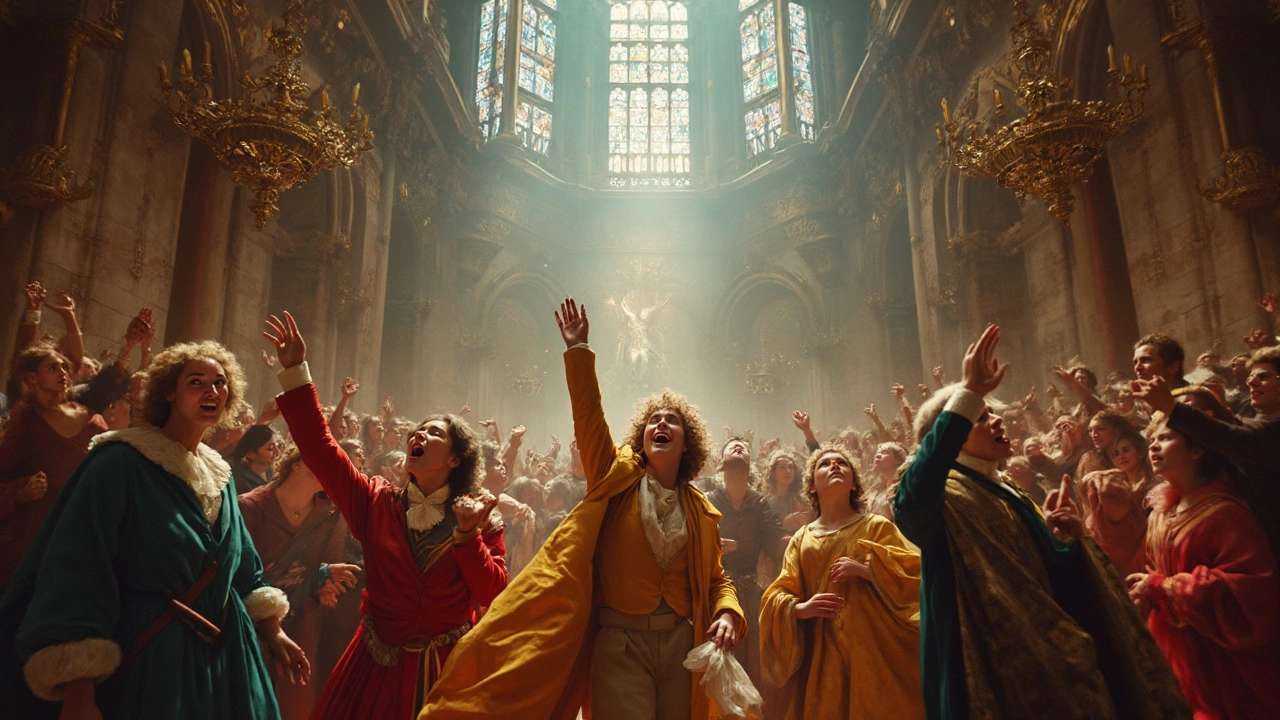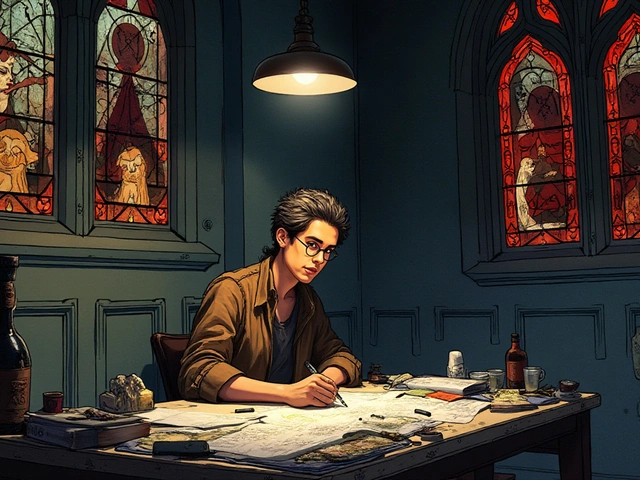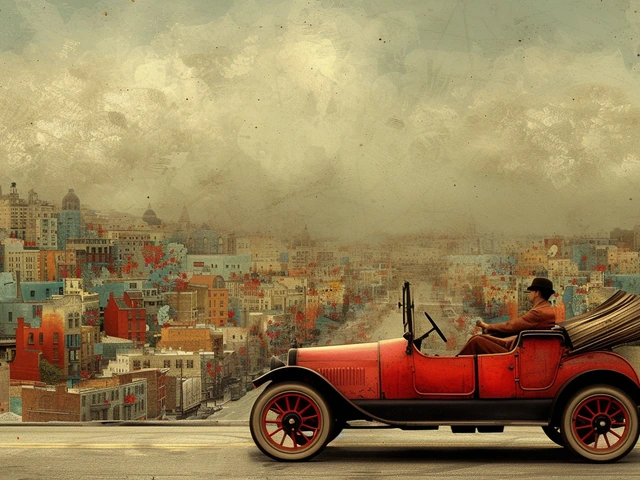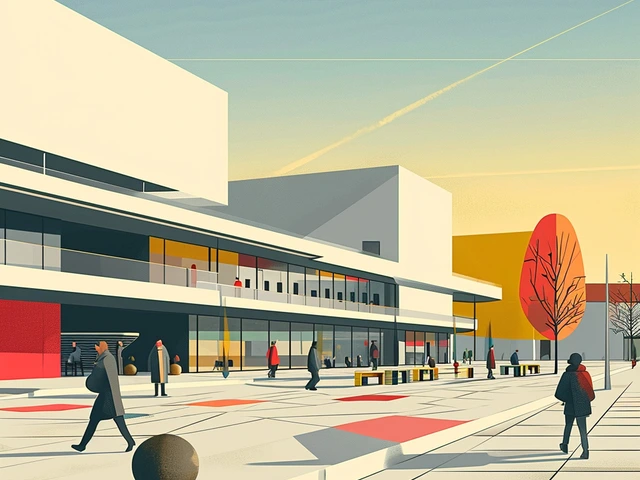Forget everything you know about art being calm or modest—Baroque art is all about grabbing your attention. Imagine walking into a church where the ceilings explode with color and drama. That's what people in 17th-century Europe wanted: art that made you feel something, fast.
If you're hunting for the basics, here’s a big one—Baroque artists loved showing strong emotions. No more stiff, posed faces or polite gestures. Instead, think gasping saints, heroic kings, angels swooping out of stormy clouds. It’s like the Netflix of its day, designed to pull people in, even if they didn’t know much about art.
Baroque painters and architects also used bold tricks like sharp light and shadow (that's why Caravaggio’s paintings look so intense) and curvy lines that guide your eyes around the whole chaos. Next time you see a building or painting from the 1600s packed with gold swirls, wild movement, or faces that look ready to jump out at you, that's Baroque showing off. Curious how it all came together and what to look for today? You’re in the right spot.
- Why Baroque Looked So Bold
- Big Names, Big Moves
- Secrets Behind the Drama
- How to Spot Baroque in the Wild
Why Baroque Looked So Bold
Ever walk into a room and instantly feel like the walls are trying to tell you something? That’s the vibe the Baroque era wanted. This style exploded in the late 1500s, mostly because the Catholic Church wanted art that was loud, emotional, and impossible to ignore. After the sober style of the Renaissance, the Baroque look was a power move—meant to impress and persuade, especially during the big religious shake-ups of the time.
One of the main reasons Baroque art looked so bold was its use of dramatic light and shadow—a trick called ‘chiaroscuro.’ Artists like Caravaggio made scenes pop with heavy contrast. Dark backgrounds aren’t just artsy; they make faces and hands stand out, almost glowing. This made emotional scenes feel alive, like you could step right in.
People also went wild for movement. Baroque paintings, sculptures, and even buildings never just sit still. Figures twist, drapery swirls, and even the ceilings seem to buckle and bend. Architects like Gian Lorenzo Bernini designed fountains and churches where everything feels like it’s in motion, which made the whole space feel electric.
Baroque’s boldness wasn’t just about looks—it was also about scale. Artists and architects made everything bigger and flashier to grab attention. You get thick gold frames, ceilings bursting with action, and so much marble you’d swear the earth might run out. By cranking up the details, they made sure no one missed the message—whether it was a church trying to awe you or a king showing off power.
So, spotting Baroque is pretty easy when you know what to look for. Just watch out for:
- Dark backgrounds with beams of light on the main action
- Faces and bodies that seem caught in a moment of high drama
- Loads of curves and swirls, especially in church décor and paintings
- Massive size and over-the-top details everywhere
The Baroque vibe is all about being big, bold, and straight-up unforgettable. No wonder this style still wows people centuries later.
Big Names, Big Moves
If you want to really get why the Baroque era hit so hard, look at the Baroque heavyweights and the wild choices they made. These artists weren't just following trends—they made the rules up as they went.
Caravaggio is the drama king of Baroque painting. He used intense contrasts, almost black shadows against super-bright light, to make scenes feel real and in-your-face. His pieces like "The Calling of Saint Matthew" set a new standard for storytelling. Caravaggio got in real trouble for street fights, but his way of painting real people with dirt under their nails changed everything. Some experts say his use of light and dark, called chiaroscuro, influenced more artists than anyone else from the time.
Gian Lorenzo Bernini took Baroque to the streets—literally. As the superstar sculptor and architect, he turned Rome into a Baroque playground with fountains like the "Fountain of the Four Rivers" and sprawling churches. His statue of "Ecstasy of Saint Teresa" is so intense that tourists still crowd around for selfies. Bernini made stone look like soft fabric, and people noticed.
Then there’s Peter Paul Rubens. He painted wild, action-packed scenes packed with bright colors and bodies twisting every which way. Rubens made it cool to show off emotions—nothing held back, and nothing subtle. Some of his works are massive, stretching up to 20 feet wide, so you literally can't ignore them.
Women didn’t just watch—Artemisia Gentileschi refused to sit on the sidelines. She was famous for fierce heroines and bold themes, and she pushed back hard against those saying only men could paint history scenes. Her piece "Judith Slaying Holofernes" shocks people even now. Her skill broke barriers for women in art, and her influence is finally getting the credit it deserves.
To see how these artists set the pace, check out the sheer numbers:
| Artist | Main Focus | Famous Work | Year |
|---|---|---|---|
| Caravaggio | Painting | The Calling of Saint Matthew | 1599-1600 |
| Bernini | Sculpture/Architecture | Ecstasy of Saint Teresa | 1647-1652 |
| Rubens | Painting | Elevation of the Cross | 1610-1611 |
| Gentileschi | Painting | Judith Slaying Holofernes | 1614-1620 |
Want to see their style up close? Search for these works online or in big city museums. You'll find a lot of attitudes, and you’ll understand why Baroque artists didn’t just stick to the rules—they broke them for good.

Secrets Behind the Drama
So what made Baroque art so powerful? It’s not just about flashy gold and swirling ribbons. The real secret is in the little tricks artists used to mess with your eyes and emotions.
First up is something called tenebrism. Caravaggio, the Italian master, used this trick all the time. He’d paint with crazy amounts of shadow and then blast part of the scene with bright light. This spotlight effect does a couple of things: it makes you focus exactly where the artist wants, and it makes everything feel more urgent and real. You can see this big time in Caravaggio’s “The Calling of Saint Matthew.” Only the important figures pop out. The rest blends into darkness.
Baroque artists also loved movement and energy. Instead of calm, balanced poses, you get twisted bodies, flying hair, people mid-action. Bernini’s sculpture “The Ecstasy of Saint Teresa” is a perfect example. It looks like she’s caught in a moment, not just sitting still for a portrait. This sense of motion makes these works feel like live theater.
Let’s not forget the backgrounds. Baroque painters rarely left a simple blank wall. You’ll see thick drapes, wild landscapes, chunky clouds—anything to add another layer of drama.
- Strong contrasts of light and dark (tenebrism)
- Twisted, moving poses instead of static ones
- Complex backgrounds that feel alive
- Details that connect stories to viewers (like reaching hands or dramatic facial expressions)
The reason behind all these techniques? Artists wanted everyday folks to understand the story right away. In a time when most people couldn’t read, pictures had to work almost like movies. If you walk into a church or museum and spot these wild, attention-grabbing touches, that’s the heart of Baroque style doing its job—making sure you can’t look away.
How to Spot Baroque in the Wild
Wondering if you're staring at a real piece of Baroque art, or maybe just something flashy from another era? There are a few dead giveaways you can look for, and you don’t need to be an art expert to catch them.
- Baroque paintings pop with drama—look for intense light and dark areas, a style called chiaroscuro. Caravaggio went big with this trick, making his figures seem like they’re hit by a spotlight and everything else fades into shadow.
- There’s usually serious emotion happening: faces show pain, joy, or shock instead of the blank stares you’d see in earlier art. In churches, saints look as if they’re mid-miracle or in the middle of a wild vision.
- Architecture isn’t quiet either. Expect twisting columns, gold everywhere, huge domes, and ceilings covered in action-packed scenes. The inside of Rome’s St. Peter’s Basilica is Baroque on steroids, with its curvy shapes and heavy use of gold and marble.
- Sculptures often look like they’re moving—draped clothes seem to ripple, and arms or legs reach into your space. Bernini’s statues, for example, look like they’re about to take a breath.
Here’s a quick spot-check table to keep in mind when you’re touring a museum or an old city:
| What to Look For | Baroque Example |
|---|---|
| Strong contrasts of light and dark | Caravaggio’s "The Calling of Saint Matthew" |
| Wild, emotional faces and gestures | Rubens' "The Elevation of the Cross" |
| Gold, curves, big statement ceilings | St. Peter's Basilica, Rome |
| Movement in sculptures | Bernini’s "Ecstasy of Saint Teresa" |
| Paintings that tell a story in one scene | Rembrandt's "The Night Watch" |
Want a simple tip? If you feel overwhelmed just standing in front of it, and it almost looks like it could jump out at you, you’re probably staring at Baroque. It’s all about bold looks and pulling every trick to keep your attention.




